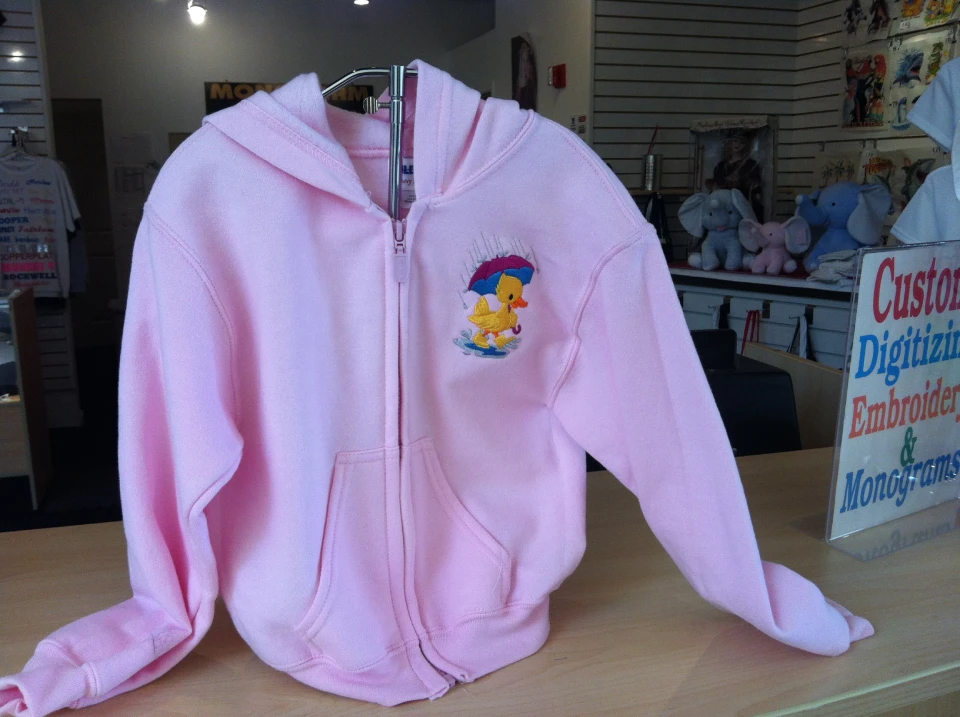Customized Mugs with Personalized Embroidery Designs for a Special Gift
The Art of Custom-made Embroidery: Opening the Tricks to Creating Special and Memorable Styles
The keys to creating custom-made needlework styles that astound the eye and leave a lasting perception lie in a fragile equilibrium of strategy, creative thinking, and attention to information. As we delve into the globe of custom embroidery, we uncover the nuanced interplay between string selection, stitch intricacy, and layout customization that raises a plain garment to a job of art.
Selecting the Right Needlework Threads
When picking embroidery strings, what vital aspects should you consider to guarantee the very best results for your customized layouts? The selection of embroidery thread is vital in identifying the last end result of your stitched layout. Among the main considerations is the product of the string. Different materials such as cotton, polyester, rayon, and silk provide differing degrees of luster, toughness, and appearance. It is necessary to choose a string material that enhances the textile you are embroidering on and lines up with the desired appearance of the design.
In addition, the weight or thickness of the thread plays a considerable role in the appearance of the embroidery. Thicker threads can add measurement and structure to your design, while finer threads are perfect for detailed information and small text. Furthermore, considering the shade fastness and washability of the string is critical to guarantee that your personalized styles maintain their high quality and vibrancy with time. By carefully examining these variables and choosing top notch strings that satisfy your particular needs, you can enhance the aesthetic charm and longevity of your embroidered productions.
Discovering Different Stitch Strategies
To explore the realm of 'Discovering Various Stitch Strategies', one should comprehend the details and subtleties that each stitching method brings to the art of embroidery. Different stitch techniques not just add visual interest but additionally contribute to the overall structure and measurement of the layout. One prominent stitch technique is the satin stitch, which includes very closely packed parallel stitches to create a smooth and glossy surface, suitable for filling out forms and developing bold outlines.
On the other hand, the backstitch is a flexible method frequently used for detailing and including fine information. It involves stitching in reverse to create a solid line of embroidery. Additionally, the French knot stitch includes a responsive component to styles, ideal for creating distinctive accents like flower facilities or ornamental touches.
Checking out various stitch strategies enables embroiderers to have fun with light, shadow, and deepness within their layouts, elevating the visual appeal and creative quality of their embroidery projects. By grasping various stitching methods, one can unlock endless opportunities for developing special and memorable custom needlework items.
Incorporating Personalized Style Components
Having explored the intricacies of different stitch techniques such as the satin stitch, backstitch, and French knot, the focus now changes towards integrating individualized style components in custom-made needlework tasks. Personalized design aspects play a vital function in making embroidery jobs absolutely one-of-a-kind and remarkable. One method to integrate personalization is by adding initials, names, or significant dates to the design. This not only includes a personalized touch but also improves the nostalgic value of the embroidery item.
An additional means to include individualized style elements is by consisting of signs or motifs that hold unique significance to the recipient or show their rate of interests and personality. For instance, including a favorite blossom, pet, or hobby-related symbol can make the needlework style more significant and individualized. Furthermore, choosing shades that reverberate with the recipient or align with the designated style can better improve the personalization of the needlework task.
Grasping the Art of Shade Control

One trick element of shade control is recognizing color theory. This consists of recognizing exactly how various colors interact with each other, the emotions they convey, and exactly how they can be incorporated to create visually appealing styles. By using color concept concepts, embroiderers can develop harmonious color schemes that enhance the total appearance of the style.
Additionally, taking notice of contrast is crucial in color control. Using contrasting shades can help particular aspects of the design pop, enhance legibility, and produce a visually vibrant needlework item. By understanding the art of shade sychronisation, embroiderers can elevate their layouts and produce remarkable pieces that reverberate with clients and customers alike.
Enhancing Structure With Advanced Needlework Stitches

French knots, for example, are ideal for adding little, elevated dots to your style, imitating the appearance of beads or creating a textured surface. Bullion knots, on the other hand, can be used to develop twisted, ropelike components that add an extravagant feel to the embroidery. Seed sewing entails small, navigate to these guys scattered stitches that can fill in areas with a speckled appearance, while turkey work develops fluffy, dimensional accents evocative animal hair or vegetation. Trying out these advanced embroidery stitches enables you to push the borders of standard embroidery and produce really unique and visually enticing textures in your layouts.
Conclusion
Finally, the art of custom embroidery includes a mix of selecting the appropriate threads, discovering different stitch strategies, including personalized design elements, grasping color control, and enhancing appearance with advanced stitches. By comprehending and applying these crucial elements, embroiderers can develop unique and remarkable try this out designs that showcase their creativity and skill. Embroidery fanatics can unlock the tricks to creating lovely and custom items that stick out and leave a long-term impact.